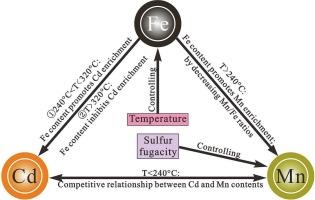MVT铅锌矿闪锌矿中镉-铁-锰耦合:对临界金属镉富集的影响
IF 3.6
2区 地球科学
Q1 GEOLOGY
引用次数: 0
摘要
镉(Cd)在现代高科技应用中的重要作用日益得到人们的认识。因此,对其自然富集机制的研究引起了科学界的极大兴趣。铅锌矿被认为是Cd的主要工业来源,主要在闪锌矿中含有这种元素,只有少量出现在独立的Cd矿物中,如绿绿岩(Cd)。目前的研究表明,闪锌矿中Cd的分布与Fe、Mn有显著的相关性,特别是通过对Cd、Fe、Mn的置换,如Fe2+ + Mn2+ + Cd2+→3Zn2+和Fe2+ + Cd2+→2Zn2+。然而,这些元素在闪锌矿中的耦合机制尚未得到彻底的研究,并且Cd富集过程的含义仍然知之甚少。在本研究中,我们分析了中国西南SYG(川云贵)地区两个主要的密西西比河谷型铅锌矿(会泽和茂坪)中不同颜色的闪锌矿样品。采用微x射线荧光(μ-XRF)、激光烧蚀电感耦合等离子体质谱(LA-ICP-MS)、同步x射线荧光(SXRF)和x射线吸收近边结构(XANES)光谱技术,对不同颜色闪锌矿中Cd、Fe和Mn的存在进行了定性和定量研究。结果表明,我们的闪锌矿样品中的铁以二价态(Fe2+)存在,浓度范围为1.2 ~ 10.8 wt%。在富铁闪锌矿中,Cd和Mn分别通过Cd2+ + nFe2+→(n + 1)Zn2+和Mn2+ + nFe2+→(n + 1)Zn2+以不同的比例与Fe一起结合到晶格中。值得注意的是,随着铁含量的增加,Cd/Fe和Mn/Fe比值逐渐降低。当Fe超过6.7 wt%时,Cd浓度急剧下降。在贫铁闪锌矿中,Cd和Mn在晶体结构上可以直接替代Zn (Cd2+→Zn2+和Mn2+→Zn2+),且两者的浓度呈负相关关系。研究表明,闪锌矿中Cd的富集主要受温度的影响,而与硫逸度的相关性不明显。镉富集在高温闪锌矿和低温闪锌矿中均可发生。因此,在较高温度条件下形成的铅锌矿床可能促进闪锌矿中Cd的两个不同富集阶段,从而提高Cd的整体浓度。本文章由计算机程序翻译,如有差异,请以英文原文为准。

Cadmium-Fe-Mn coupling in sphalerite from MVT Pb-Zn deposits: Implications for critical metal Cd enrichment
Cadmium (Cd) has been increasingly recognized for its critical role in modern high-technology applications. Accordingly, investigations into its natural enrichment mechanisms have garnered heightened scientific interest. The Pb-Zn deposit, recognized as the principal industrial source of Cd, predominantly hosts this element within sphalerite, with only minor occurrences in independent Cd minerals such as greenockite (CdS). Current studies have demonstrated that the distribution of Cd in sphalerite is significantly correlated with Fe and Mn, particularly through the substitutions of Cd, Fe, and Mn, such as Fe2+ + Mn2+ + Cd2+ → 3Zn2+ and Fe2+ + Cd2+ → 2Zn2+. However, the coupling mechanism of these elements within sphalerite have not been thoroughly investigated, and the implications of the Cd enrichment process remains poorly understood. In this study, we analyzed sphalerite samples of varying colors from two major Mississippi Valley-type (MVT) Pb-Zn deposits (Huize and Maoping) in the SYG (Sichuan-Yunnan-Guizhou) area, Southwest China. We employed micro-X-ray fluorescence (μ-XRF), laser ablation inductively coupled plasma–mass spectrometry (LA-ICP-MS), synchrotron X-ray fluorescence (SXRF), and X-ray absorption near-edge structure (XANES) spectroscopy techniques to qualitatively and quantitatively investigate the presence of Cd, Fe and Mn in sphalerite of different colors. The results demonstrate that Fe in our sphalerite samples exists in a divalent state (Fe2+), with concentrations ranging from 1.2 to 10.8 wt%. In Fe-rich sphalerite, Cd and Mn incorporate into the lattice alongside Fe at varying ratios via the substitutions Cd2+ + nFe2+ → (n + 1)Zn2+ and Mn2+ + nFe2+ → (n + 1)Zn2+, respectively. Notably, as Fe content increases further, both the Cd/Fe and Mn/Fe ratios decrease progressively. Cd concentrations drop sharply when Fe exceeds 6.7 wt%. In Fe-poor sphalerite, Cd and Mn can directly substitute for Zn within the crystal structure (Cd2+ → Zn2+ and Mn2+ → Zn2+), and their concentrations exhibit an inverse correlation. This study indicates that the enrichment of Cd within sphalerite is predominantly influenced by temperature, while its correlation with sulfur fugacity appears to be insignificant. Cadmium enrichment can occur in both high-temperature and low-temperature sphalerite. Consequently, the Pb-Zn deposits formed under higher temperature conditions may facilitate two distinct stages of Cd enrichment in sphalerite, thereby enhancing overall Cd concentration.
求助全文
通过发布文献求助,成功后即可免费获取论文全文。
去求助
来源期刊

Ore Geology Reviews
地学-地质学
CiteScore
6.50
自引率
27.30%
发文量
546
审稿时长
22.9 weeks
期刊介绍:
Ore Geology Reviews aims to familiarize all earth scientists with recent advances in a number of interconnected disciplines related to the study of, and search for, ore deposits. The reviews range from brief to longer contributions, but the journal preferentially publishes manuscripts that fill the niche between the commonly shorter journal articles and the comprehensive book coverages, and thus has a special appeal to many authors and readers.
 求助内容:
求助内容: 应助结果提醒方式:
应助结果提醒方式:


